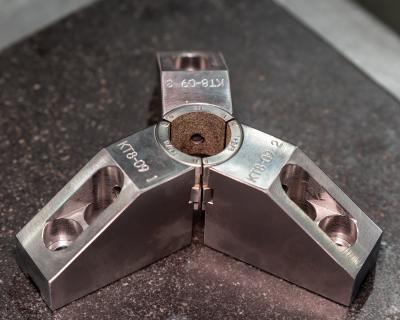
Precision ground collet pads provide tight tolerances for workpieces, with full contact across the gripping surface for greater holding power. When combined with Carbinite coating, Dillon Collet Pad Top Jaws allow more aggressive machining which yields shorter cycle times. Round smooth, round serrated, hex smooth, and square smooth sizes are available for W&S (all sizes), S-style (all sizes), Gisholt, Jones & Lamson, and Martin collet pad types, allowing more varied geometries can be securely gripped. The ability to quickly change between sizes allows shops to expand their machining capabilities, increase their machine cycles by up to 30%, and maximize production. Emergency collet pads that machine like top jaws are stocked for custom workpiece applications. Dillon collet pads and jaws are ideal for precision boring, high-speed machining, tapping, drilling and finishing. They are especially suited for small diameter machining of stems, spools, crimp assemblies, manifolds for high pressure air systems, medical parts, miscellaneous fittings, mechanical and transmission components and specialty valves, and more.
Systems that can convert thru-hole chucks to hold small bar and tube stock are available. Changing over to collet pad jaws is easily accomplished in just minutes with simply a jaw change, which is much faster and easier than changeover of entire chucks. The use of collet pad jaws allows users to maximize their chuck capabilities and more fully amortize their chuck investment by performing both chuck and collet pad projects.
All products are designed and manufactured by skilled and experienced engineers, using an integrated computer system tracks production, in ISO 9001:2015 facilities.
All Dillon Manufacturing products are Made in the USA.
Contact Details
Related Glossary Terms
- boring
boring
Enlarging a hole that already has been drilled or cored. Generally, it is an operation of truing the previously drilled hole with a single-point, lathe-type tool. Boring is essentially internal turning, in that usually a single-point cutting tool forms the internal shape. Some tools are available with two cutting edges to balance cutting forces.
- chuck
chuck
Workholding device that affixes to a mill, lathe or drill-press spindle. It holds a tool or workpiece by one end, allowing it to be rotated. May also be fitted to the machine table to hold a workpiece. Two or more adjustable jaws actually hold the tool or part. May be actuated manually, pneumatically, hydraulically or electrically. See collet.
- collet
collet
Flexible-sided device that secures a tool or workpiece. Similar in function to a chuck, but can accommodate only a narrow size range. Typically provides greater gripping force and precision than a chuck. See chuck.
- tapping
tapping
Machining operation in which a tap, with teeth on its periphery, cuts internal threads in a predrilled hole having a smaller diameter than the tap diameter. Threads are formed by a combined rotary and axial-relative motion between tap and workpiece. See tap.

